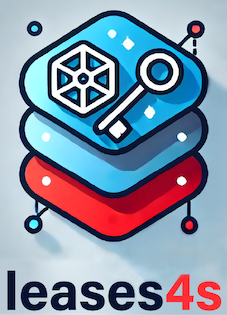Functional abstractions for leases in Kubernetes allowing for use cases such as distributed locking, leader election, map-reduce, cluster formation, and more.
Add the following dependency to your build.sbt:
libraryDependencies += "io.github.jchapuis" %% "leases4s-core" % "x.y.z" // latest from maven badge aboveFor a more in-depth explanation, make sure to check out the blog article.
As its name suggests, the library is all about leases and everything revolves around these two main abstractions:
The Lease trait is the main abstraction of the library. It represents a lease in Kubernetes, and is parametrized by the effect type F. The lease has an identifier, can bear labels for filtering, and has support for metadata in the form of annotations. A lease has a holder and can expire: expiry can be observed via an FS2 stream:
trait Lease[F[_]] {
def id: LeaseID
def holder: F[HolderID]
def labels: F[List[Label]]
def annotations: F[List[Annotation]]
def isExpired: F[Boolean]
def expired: fs2.Stream[F, Unit]
}Leases are obtained from a LeaseRepository, which defines a distributed lease repository, with the ability to acquire leases with automatic renewal, check for other existing leases and watch for related events. A repository is created with a set of labels that act as a filter in Kubernetes to identify the leases it manages. The repository is also configured with parameters for lease acquisition and renewal: leases are automatically renewed before they expire while an active holder node exists.
trait LeaseRepository[F[_]] {
def labels: List[Label]
def acquire(id: LeaseID, holderID: HolderID, annotations: List[Annotation] = Nil)(implicit
parameters: LeaseParameters = LeaseParameters.Default
): Resource[F, HeldLease[F]]
def get(id: LeaseID): F[Option[Lease[F]]]
def list: F[List[Lease[F]]]
def watcher: fs2.Stream[F, LeaseEvent[F]]
}Based on this fundamental abstraction of a distributed lease, one can build a surprising number of higher-level patterns. Patterns are presented below in order of increasing complexity.
Holding a distributed lease can be used to protect a critical section of code. The guard pattern is a simple pattern that acquires a lease, runs a critical section of code, and releases the lease when the critical section is done. The lease is automatically renewed while the critical section is running.
This pattern is accessible easily directly when acquiring a lease from the repository: acquire returns the HeldLease type, which is a Lease with the added guard method:
trait HeldLease[F[_]] extends Lease[F] {
def guard[A](fa: F[A]): F[Outcome[F, Throwable, A]]
}guard runs fa guarded by the lease, thus implementing a distributed critical section
- if the lease is still held after completion of the action, the outcome is Outcome.Succeeded
- if the lease is already expired or expires in the meantime, the action is cancelled and the outcome is Outcome.Canceled
- if the action fails, the outcome is Outcome.Errored
The lease is auto-renewed in the background, so in nominal conditions there is no reason for it to expire during the action. However, in case of loss of connectivity to the lease issuer or some other issue preventing renewal of the lease, it may expire before the action completes. In such cases, the action is cancelled and the outcome is Outcome.Canceled.
Note that this pattern does not per-se ensure transactional semantics, as cancellation is best-effort. In other words, if we fail to renew the lease, and it gets revoked while running the action, cancellation or rollback must run before the lease expires. Otherwise, it is possible that another node acquires the lease upon expiry and enters the critical section while we are still trying to exit. If strict transactional semantics are required, the action should use some additional form of strong consistency, like version control or idempotent operations.
The bundled example application illustrates a number of these patterns on a real k3d kubernetes instance running locally together with AWS LocalStack for compelling examples. The app is deployed using pulumi and the besom scala plugin.
The example application is a static website of books running from an S3 bucket for fast read access. Book upload is implemented by a scala service running in kubernetes, replicated for high availability and scale.
The books index can be sorted by name, word count and description. This is implemented by three respective static index.html, index-by-word-count.html and index-by-description.html files that are updated by the upload service upon each book upload. These three indices must be kept in sync so that all books are listed in the proper order at all times. Of course, book uploads can happen at any time, potentially triggered by various users simultaneously. To ensure consistency of these updates in the case of such parallel upload operations, the service uses the guard pattern to acquire a distributed lease before updating the indices.
The interesting bits of the application can be found in FileUploader.scala. This class takes an S3AsyncClient in parameter and a LeaseRepository. The crux of the demonstration happens in the safeUpdateIndexFiles method:
private def safeUpdateIndexFiles(newFile: IndexPage.File) =
leaseRepository
.acquire(LeaseID(ks"file-uploader"), HolderID.unique)
.use(_.guard(updateIndexFiles(newFile)).map(_.embedError))The updateIndexFiles method is the critical section that updates the three index files, guarded by the file-uploader kubernetes lease while the operation is running.


